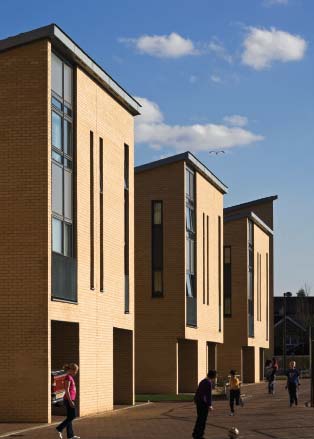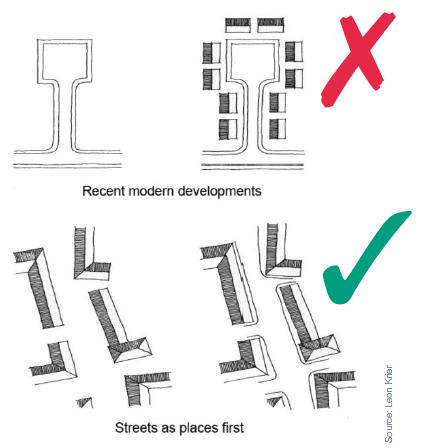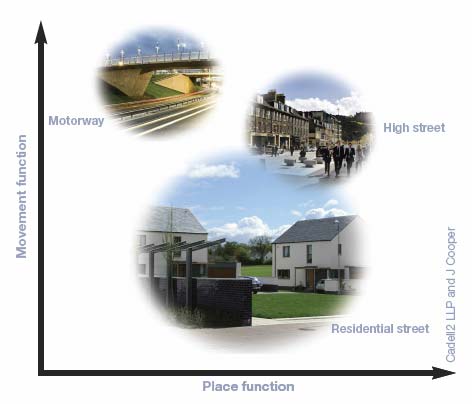Designing Streets: A Policy Statement for Scotland
Designing Streets is the first policy statement in Scotland for street design and marks a change in the emphasis of guidance on street design towards place-making and away from a system focused upon the dominance of motor vehicles.
Part 01 General: Creating streets and places

Keith Hunter
Creating streets and places
Good street design can promote a better quality of living for everyone. Sustainable patterns of behaviour can be influenced greatly by the intelligent design of streets. It is therefore essential that all parties involved in street design ensure that streets contribute as positively to their environment as is possible.
Creating good streets is not principally about creating successful traffic movement: it is about creating successful places.
policies
- Street design must consider place before movement
- Street design guidance, as set out in this document, can be a material consideration in determining planning applications and appeals
Streets have two key functions: place and movement.
In the more recent past, vehicle movement has often dominated the design of streets, resulting in many streets being out of context with their location and overly influenced by prescriptive standards. The prime concern of Designing Streets, in contrast, is to reverse this trend and shift the focus firmly back to the creation of successful places through good street design.
A 'sense of place'
A sense of place can be considered as the character or atmosphere of a place and the connection felt by people with that place. A positive sense of place is fundamental to a richer and more fulfilling environment. It comes largely from creating a strong relationship between the street and the buildings and spaces that frame it. A positive sense of place encompasses a number of aspects, most notably the street's:
- local distinctiveness;
- visual quality; and
- potential to encourage social and economic activity.
Consider the place before vehicle movement

Source: Leon Krier
Movement
Providing for movement along a street is vital, but it should not be considered independently of the street's other functions. The need to cater for motor vehicles is well understood by designers, but the passage of people on foot and cycle has often been neglected. Walking and cycling are important modes of travel, offering a more sustainable alternative to the car, making a positive contribution to the overall character of a place, public health, social interaction and to tackling climate change through reductions in carbon emissions.
Achieving the right balance between place and movement
Streets should no longer be designed by assuming 'place' to be automatically subservient to 'movement'.
Good street design demands that issues of place and movement are considered together. The status of a street is dependent on its relative importance within a network in terms of both these considerations, and its status should commonly determine the design approach taken. It is only by considering both functions that the right balance will be achieved, but the focus of street design should be on creating a positive sense of place that is supported by an appropriate movement pattern. Other than in the design of motorways and some other inter-urban roads, it is seldom appropriate to focus solely on either place or movement functions, even in streets carrying heavier volumes of traffic, such as high streets.
Place status denotes the relative significance of a street, junction or section of a street in human terms. The most important places will usually be near the centre of any settlement or built-up area, but important places will also exist along arterial routes, in district centres, local centres and within neighbourhoods.
In new developments, locations with a relatively high place function would be those where people are likely to gather and interact with each other, such as outside schools, in local town and district centres or near parades of shops. Streets that pass through these areas need to reflect the importance of these places in their design, which in new developments should be identified at the masterplan/scheme design stage.
Movement status can be expressed in terms of traffic volume and the importance of the street, or section of street, within a network. Movement status should be considered in terms of all modes of movement, including vehicle traffic, pedestrian and cycle flows and public transport. Movement status can vary along the length of a route. Another way of assessing the movement status of a street is to consider the geographical scale of the destinations it serves. Here, movement status can range from national networks (including motorways) through to city, town, district, neighbourhood and local networks, where the movement function of motor vehicles is slightly lower.
place
comes first
Place and movement matrix
Defining the relative importance of particular streets/roads in terms of place and movement functions should inform subsequent design choices. For example:
- motorways - high movement function, low place function;
- high streets - medium movement function, high place function; and
- residential streets - low to medium movement function, medium to high place function.
This way of looking at streets can be expressed as a two-dimensional matrix (right) where the axes are defined in terms of place and movement. Areas where people are likely to gather and interact with each other will have a high place function.
The matrix recognises that, whilst some streets are more important than others in terms of traffic flow, some are also more important than others in terms of their place function and deserve to be treated differently. This approach allows designers to break away from previous approaches to hierarchy, whereby street designs were only based on traffic considerations.
Once the relative significance of the movement and place functions has been established, it is possible to set objectives for particular parts of a network. This will allow the local authority to select appropriate design criteria for creating new links or for changing existing ones.
Movement and place considerations are important in determining the appropriate design speeds, speed limits and urban structure, along with the level of adjacent development and traffic composition.
Street design guidance, as
set out in this document, can
be a
material consideration
in determining planning
applications and appeals
Planning Permission may be refused and the refusal defended at appeal or local review solely on design grounds.
Designing Streets is national planning policy and its policies should be taken into account by local authorities when determining planning applications and producing guidance. Designing Places and Designing Streets stand together as the two key design policy statements for Scotland.

Cadell2 LLP and J Cooper
There is a problem
Thanks for your feedback